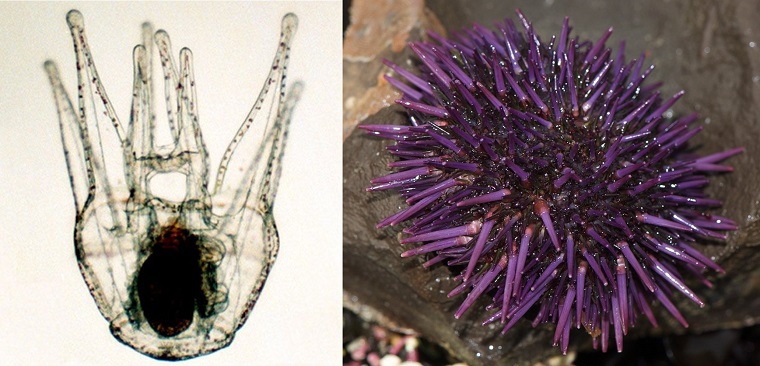Growing Up is Hard: Study Explains High Mortality in Sea Urchins Following Metamorphosis
By Madison Wright
2 August 2019

A caterpillar turning into a butterfly may be the most familiar example of the dramatic transformation known as metamorphosis, but it is far from the only one. In addition to numerous other insect species and amphibians, sea urchins also undertake a drastic transition as they develop into adults.
A sea urchin begins life as a tiny, microscopic-sized larva. After a few weeks spent swimming freely and feeding, it metamorphoses into a juvenile urchin, a smaller version of the more readily recognized spiky adult form. It is at this time that the juvenile urchin also settles onto a surface where it will grow for the rest of its life – sometimes for over 100 years!
This metamorphic transition has fascinated Prof. Andreas Heyland, a developmental biologist in the Department of Integrative Biology, since his days as a graduate student.
“Metamorphosis in sea urchins is a radical transition where almost all of the larval components are removed and juvenile components develop,” says Heyland. It’s a remarkable process, but also one that is fraught with difficulty; over 90 percent of sea urchins do not survive this stage of their development in the laboratory, and likely in the natural world as well.
According to Heyland, one potential explanation for this high mortality rate could be the lack of a functional mouth for the first few days following metamorphosis. During this period, a juvenile sea urchin must rely entirely on the lipid reserves it accumulated as a larva for energy. Having previously shown that nutritional stress as a larva can be carried over into the early juvenile stage, Heyland and graduate student Alyaa Elsaid Abdelaziz Fadl decided to explore if lack of sufficient nutrients following metamorphosis might also contribute to the high mortality rate during this period.
Using high resolution imaging techniques, Fadl and Heyland determined that the physical components of the mouth are present soon after metamorphosis, but a delay in muscle development means that the mouthparts are not functional for several days and leave the mouth effectively closed. In fact, it is not until a full four days post-settlement that the mouthparts become fully developed and functional, representing an extended period of nutritional stress for the juvenile urchin.
Fald and Heyland also used molecular techniques to investigate changes in gene expression levels during this timeframe. They found that a gene associated with nutritional stress is expressed more abundantly before the mouth becomes functional. The gene is expressed primarily in the juvenile sea urchin’s tube feet where key sensory organs happen to be located; this suggests that the gene may be involved in “sensing” nutrients that trigger key cellular events related to development, a process known as nutrient signalling.
Overall, the results offer new insights into the mechanisms that regulate early development – and survival – in juvenile sea urchins. In particular, the role of nutrients in driving important physiological processes at this stage of growth is just beginning to be understood, says Heyland. “Nutrient signalling is complex and we are really just looking at the tip of the iceberg. There are a lot of other genes that we need to monitor to better understand this process.”
Not surprisingly, the Heyland laboratory plans to continue its study of this phenomenon. They are especially interested in better understanding how the experiences of the sea urchin larvae, including temperature, nutrient availability and salinity stress, affect their performance as juveniles.
Such questions are fascinating to anyone with an interest in biology, but they also have important implications for the aquaculture industry, where sea urchins are increasingly grown as a high value delicacy.
“Sea urchin juvenile mortality rates are massive even in an aquaculture setting, so knowing how the metamorphic transition can be optimized is critical,” says Heyland. “If it turns out that larval nutrition has a large impact on the early mortality, you could change the diet of the larvae in the hatcheries. Or, if it is a bottleneck effect where mortality occurs because they can’t feed for a short period of time, you can enrich the water with dissolved organic matter to provide them with nutrients since they are capable of getting food without using their mouth.”
With so many questions about sea urchin metamorphosis and development still unanswered, there are exciting research opportunities ahead for Heyland and colleagues. “This project has provided us with a good focal point for this research going forward. I am excited about this research because it started as just a side project in my laboratory but has become more relevant based on what we have found.”
This study was funded by the Natural Sciences and Engineering Research Council.
Read the full study in the journal Invertebrate Reproduction & Development.
Read about other CBS Research Highlights.